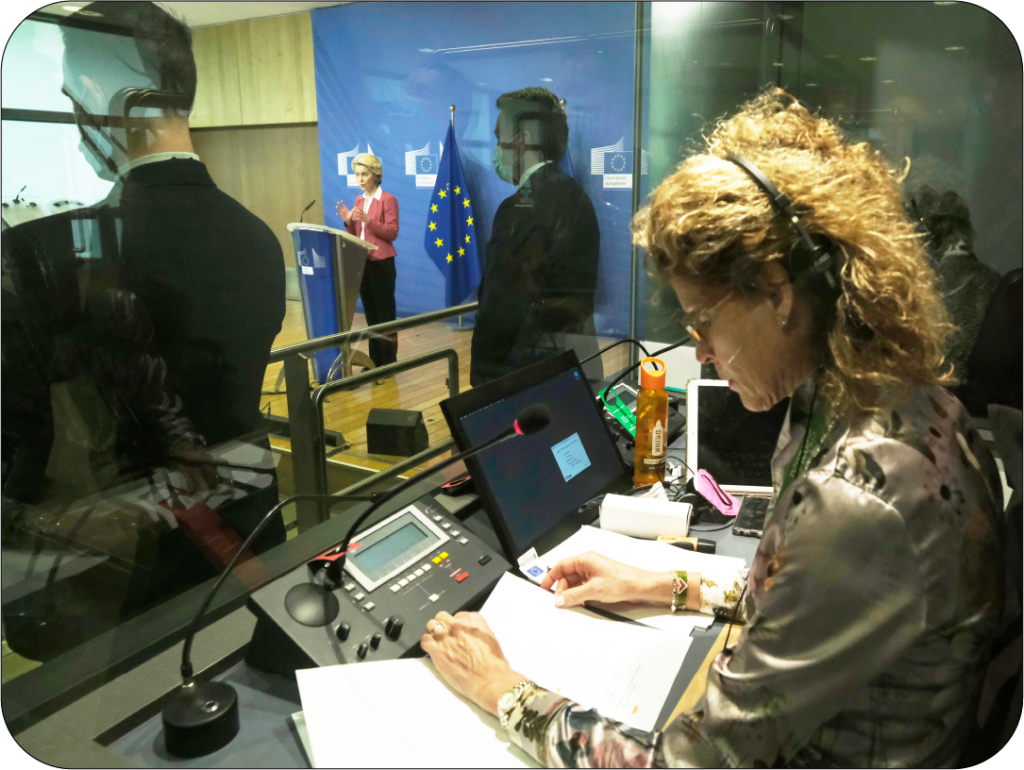Conference Interpretation
Absolute Translations offers expert conference interpreting services for national and international events.
Our interpreters regularly interpret at the European Commission, G20 summits, APEC, NATO, UN, WTO, IMF and more. We also offer conference interpreters for VIP purposes (consecutive and bilateral interpreting).
We guarantee AIIC certification and NAATI accreditation at the senior and advanced interpreting levels for every conference.
Simultaneous Interpretation

Conference interpreters translate spoken language, in real time. A thorough knowledge of languages, nerves of steel, attention to detail and boundless curiosity are the hallmarks of the professional interpreter.
Concentration, speed of thought, mental dexterity as well as a broad general knowledge are all of the essence, coupled with the ability to keep calm when it gets stressful, which it often does!
Interpreters work at every kind of meeting and in any venue. They work for the major international organisations and for business clients.
All professional interpreters have undergone demanding training, many of them at postgraduate level, and they constantly hone their skills on professional development courses.
Thanks to their experience and versatility they can cover any subject – the secret is thorough preparation combined with boundless curiosity.
Qualifications, Accreditations and Guarantees
Individually selected for your specific requirements
Worldwide pool of qualified simultaneous interpreters available
Bound by confidentiality agreements and AIIC Code of Ethics
Available for remote simultanous interpretation online
Modes of interpreting

Simultaneous Interpreting
In an ISO4043 compliant sound-proof booth with direct view of the speaker, the interpreter listens to a speaker through earphones and renders the message into another language through the microphone. The listeners receive the interpretation via headphones.
The interpreter translates the message simultaneously, in real-time. Unlike consecutive interpreting, this way the natural flow of the speaker is not disturbed and allows for a fairly smooth output for the listeners.
Consecutive Interpretation
Consecutive interpreters listen to the speaker and convey the message into another language after the speaker has paused. Typically, the speaker will pause at regular intervals to give the interpreter time to convey the message.
Common settings are healthcare and business. Interpreting consecutively requires intense active listening, memory recall, and note-taking to produce an accurate interpretation, since the speaker may speak for several minutes before pausing.

Whisper Interpretation
Whisper interpreting (also known as chuchotage) is used when a full audio setup for simultaneous interpreting is not available. The interpreter listens to the presenter and then whispers the translation to an attendee, so that their voice does not impact the presentation.
A whispered interpretation is generally a summary of what is said and is not the same as a “simultaneous interpretation” without technical equipment. It must be limited to a maximum of two participants around each interpreter.
Frequently Asked Questions
What is simultaneous or conference interpreting?
As the name suggests, simultaneous interpreting is when the onsite interpreter translates communications at the same time as the original speaker is talking.
Simultaneous interpreting is facilitated by ISO compliant booth equipment, where the interpreter listens to a speaker through earphones and renders the message into another language through the microphone. The listeners receive the interpretation via headphones.
What skills does a simultaneous conference interpreter need?
The skills required for simultaneous interpretation are almost the same as those used in consecutive interpretation. The main difference is that all three are happening at the same time, which significantly increases the complexity of the task.
The interpreter needs to possess three core skills:
- Comprehension skills – Since the purpose of listening is different, it is not as simple as it may seem. People in general listen to take part in a conversation, versus listen to remember full dialog so that they can accurately translate the message.
- Note taking (analytical) – This requires the ability to differentiate primary and secondary information and prioritise it as such. In addition to the ‘what,’ an interpreter must also remember the ‘who,’ ‘why,’ ‘where’ and ‘how.’ This means who said what, when and where, whether the speaker has an opinion on it, and so on.
- Communication skills – Great short-term memory is the first skill needed here. Thereafter, the interpreter should be able to quickly make sense of the message, which could be in the form of their notes, and translate the message in a captivating way.
Along with all the skills needed for consecutive interpretation, including listening to translate, differentiating and prioritising primary and secondary information and great memory skills, simultaneous interpreters must anticipate what the speaker is likely to say as well.
This is particularly important when the original language and target language have vastly different syntactical structures.
Simultaneous interpreters are under a great deal of pressure since they have to actively listen while analysing and translating the message at the same time.
As a result, they must have the ability to excel in high-stress situations and have stronger language skills that allow them to do everything required of them simultaneously.
What are the nuances between simultaneous vs consecutive interpreting?
There’s more than one way to interpret a conference. The two main styles of conference interpreting services are simultaneous conference interpreting services and consecutive conference interpreting services. Simultaneous interpreting is that impressive real-time translation we mentioned earlier, where the interpreter speaks almost alongside the original speaker. It’s a thrilling game of mental back n forth ping-pong, demanding razor-sharp focus and the ability to anticipate what comes next.
Consecutive interpretation, on the other hand, takes a more deliberate approach. The interpreter waits for the speaker to finish a section, then translates it into the target language. This method allows for in-depth translation, capturing the speaker’s intent, tone, and even the emotional nuances with greater precision. Think of it as a skilled sculptor carefully crafting a replica, ensuring every detail is faithfully reproduced. This style is ideal for smaller meetings or situations where complex information needs to be conveyed with absolute clarity.
How do I choose the right conference interpreter agency?
You’re planning a multilingual conference and need first class conference interpretation services. How do you navigate through the world of conference interpreting agencies? Firstly, consider the languages you need. Reputable agencies boast a network of experienced interpreters covering a vast range of languages, from the most common like Spanish and French to more specialized languages needed for niche conferences.
Next, delve into the nitty-gritty of your event. Is it a high-powered tech summit requiring specialized terminology in areas like artificial intelligence or biotechnology? Or is it a cultural exchange where capturing the emotional undercurrent and the essence of the speaker’s message is key? A good agency will take the time to understand your specific needs and match you with interpreters who have expertise in your field.
Do you still include human touch in conference interpretation?
Technology is making strides in the world of translation, but conference interpretation still remains very much a human endeavor. A conference translator isn’t just a language guru; he or she is a cultural ambassador who bridges the gap between languages and indeed, cultures. Understanding cultural nuances and references ensures the translated message resonates with the audience on a deeper level.
Imagine a presenter cracking a joke that relies on wordplay specific to their language. A skilled interpreter won’t just translate the literal meaning; they’ll find an equivalent joke in the target language, preserving the humor and keeping the audience engaged. This human touch is what elevates interpretation from simple translation to a bridge that fosters genuine connection, ensuring the message transcends mere words and reaches the hearts and minds of the audience.
Why does conference interpretation matter?
In today’s interconnected world, cross-cultural communication is more important than ever. Conference interpretation breaks down language barriers, allowing for the exchange of ideas, the forging of partnerships, and the collective pursuit of progress. Whether it’s a scientific breakthrough being shared with the world or international entrepreneurs collaborating on a groundbreaking project, conference interpretation ensures everyone has a seat at the table and can contribute their unique perspective.
The next time you attend a multilingual event, take a moment to appreciate the interpreters working behind the scenes. They are the silent heroes who bridge the gap between languages.
How do you bridge the language divide during a conference?
Imagine a room pulsating with energy, a vibrant tapestry of languages woven together by a captivating presentation. Attendees from all corners of the globe nod, smile, and jot down notes – but a silent struggle simmers beneath the surface. A joke lands with a smattering of confused laughter in one corner, and a technical term leaves some brows furrowed in another. How can everyone truly grasp the speaker’s message, the humor, the emotional undercurrent, when tongues don’t quite meet?
Enter the engaging world of conference interpretation, where skilled professionals connect a bridge of understanding across cultural divides. Seated in soundproof booths, headsets their essential lifeline, they transform the speaker’s words into a symphony of languages. They are the conference interpreters, the unsung heroes who make seamless communication in a multilingual world possible. They are the invisible orchestra conductors, ensuring a harmonious exchange of ideas despite the linguistic differences in the room.
The art of interpreting - what is it?
Conference translators embody the art of dismantling language barriers, fostering genuine connection, and propelling us towards a more interconnected world.
Have you ever witnessed a conference interpreter in action? Imagine a bustling conference room, a confusing sound of languages swirling around the room. In the midst of this vibrant connection of cultures, the interpreter sits with laser-sharp focus, their gaze fixed on a screen displaying the speaker’s image. A headset, connects them to the speaker’s voice, a torrent of words flowing at a seemingly impossible pace. Yet, these conference translators aren’t simply passive listeners. With the dexterity of a master, their fingers dance across a keyboard, their mind a whirlwind of translation.
Remarkably, almost simultaneously with the original speaker, they transform the words into another language, ensuring the message reaches every corner of the room. It’s a performance that demands not just fluency in multiple languages, but an exceptional ability to listen, process information at lightning speed, and translate on the fly. Imagine a skilled jazz musician improvising a complex melody in perfect harmony with the soloist – that’s the essence of a conference interpreter in action. They are the invisible orchestra conductors, wielding the power of language to ensure a harmonious exchange of ideas despite the multi-language all in one room together. These are the unsung heroes who make conference interpretion services possible – who foster understanding, dismantle communication barriers, and lead us to a more connected world. The next time you attend a multilingual event, take a moment to appreciate the remarkable skill and dedication of these conference interpreters.
For other sessions like business meetings, video conferences and medical appointments, we offer the following services:
Onsite Interpreting
While OPI and VRI may be appropriate in an emergency or when faced with unexpected problems such as location or travel restrictions, onsite consecutive interpreting can be ideal for longer appointments or where an onsite interpreter is required.
This service must be booked in advance, and travel charges may apply.
Video Interpreting (VRI)
Video Remote Interpreting helps people interact more personally than traditional telephone interpreting owing to the visual context and cues. Our LINK platform offers a smooth video call experience for a better remote interpreting experience.
VRI is available on a scheduled or on-demand basis.
Onsite Scheduling Tool
Our interpreting scheduling tool allows for easy management of customer appointments and corresponding interpreters. Administrators and language service managers can track service requests and expenses directly through the platform.
Automate workflows and broadcast your appointments to interpreters or select your preferred interpreter directly from the platform.
Languages
We cover all major languages in Australia as well as languages spoken by migrant & refugee communities. We also offer rare & emergent languages such as Pacific Island languages or African dialects. We can also connect you to Indigenous interpreters who assist you with Aboriginal & Torres Strait Islands languages.
We always endeavour to assign interpreters fluent in regional language variations such as Sudanese Arabic or Mexican Spanish.





